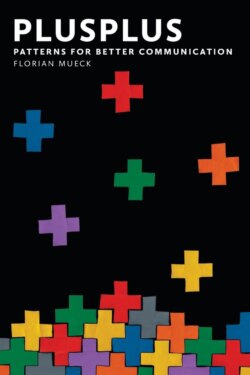Читать книгу PlusPlus - Florian Mueck - Страница 6
На сайте Литреса книга снята с продажи.
ОглавлениеHer name is Sonia, and she’s from Mexico City. When I met her, I was about to give a seminar for the Foundation of Emotional Education in Barcelona. Everyone was chatting and chaffering over their coffee before the training started — except Sonia, who was sitting alone at a table, hunched forward, poring over some notes.
I went over to her table and sat down. Instead of introducing myself, I just looked at her. Then I said: You don’t talk very much, do you?
She answered: No.
Sonia was an introverted, timid, pensive person when I met her. She was insecure, reluctant to share even her ideas, much less her feelings, or her passions. It was as if she’d built a wall around herself, and was hiding behind it from everyone.
Two days later she had changed completely. Enthusiasm possessed her when she expressed her passion for archaeological museums. She modulated her voice to outstanding effect. She was poised; her selfconfidence had soared. Now she positively radiated charisma. It was like magic.
What had happened to Sonia?
I lead seminars on public speaking. That is my profession. I’ve worked all across Europe, usually for major corporations. I’ve listened to and evaluated thousands of speeches — in three languages — and these thousands of evaluations have taught me one thing: the power of feedback!
I use only positive, constructive feedback: that is the secret magic of PLUSPLUS.
PLUS: Sonia, what I liked in your speech was....
PLUSPLUS: Sonia, what you could have done even better was..
Who likes negative feedback? Who accepts MINUS feedback?
In my seminars, MINUS feedback is not allowed.
I always turn MINUS feedback into PLUSPLUS comments, so the people receiving it, like Sonia, don’t begin to think in terms of what they did wrong; instead, they think about how they can do it better next time.
Examples of MINUS versus PLUSPLUS feedback:
MINUS: You spoke too fast.
PLUSPLUS: You could’ve spoken more deliberately.
MINUS: I missed some pauses.
PLUSPLUS: You could’ve used a few more pauses.
MINUS: I didn’t like your hectic movements.
PLUSPLUS: If you exercise more control over your movements on stage, you’ll project more authority.
MINUS: You use too many filler sounds, like “um” and “ah”.
PLUSPLUS: You could convert those filler sounds you use, like “um” and “ah”, into very effective pauses instead.
MINUS: You are an emotional refrigerator.
PLUSPLUS: If you’d open up more and share your emotions, you’d connect much more with your audience.
It was the magic of PLUSPLUS, the approach that emphasizes “What you can do even better!” that turned Sonia into an outgoing, confident, passionate and persuasive communicator in just two days.
In this book you’ll learn about more than a hundred PLUSPLUS patterns I’ve detected over the years — patterns for better communication.
You can use this book in a variety of ways:
As a business presenter, you can enhance your content, your delivery, and your slides.
As a salesperson, you can optimize your sales pitch.
As a Toastmaster, you can improve your evaluations.
This book discusses public speaking. And consider: it’s always public speaking, whether you’re speaking to a single person or in front of an audience of a thousand people.
Many of the PLUSPLUS patterns in this book also apply to your everyday communication, one-on-one, both in business and in your personal life.
You too can improve the same way Sonia did. After two days of receiving PLUSPLUS feedback and applying PLUSPLUS patterns, she said:
On Friday I was on the other side of the river. You brought me over to this side.
